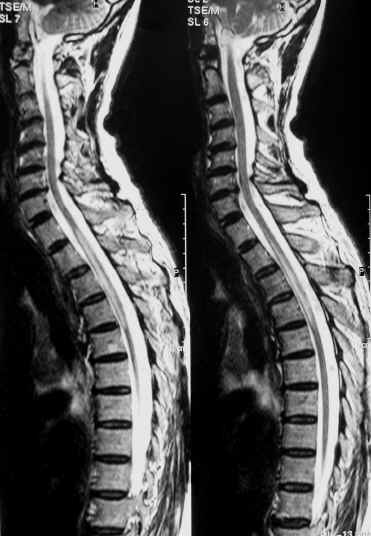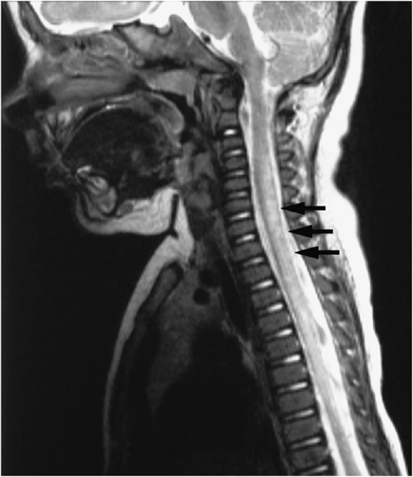Transverse myelitis Definition
Page Contents
- 1 Transverse myelitis Definition
- 2 Transverse myelitis Symptoms
- 3 Transverse myelitis Incidence
- 4 Transverse myelitis Causes
- 5 Transverse myelitis Diagnosis
- 6 Transverse myelitis Treatment
- 7 Transverse myelitis Home Treatment
- 8 Transverse myelitis Prognosis
- 9 Transverse myelitis Complications
- 10 Transverse myelitis Pictures
Transverse myelitis (TS) is a condition characterized by the inflammation of the spinal cord, which often affects the myelin or the insulating substance that covers nerve cell fibers. The disorder may cause injury to the spinal cord and result in reduced or absent sensations below the point of injury.
Transverse myelitis Symptoms
The signs and symptoms of this disease generally develop fast over a period of few hours and tend to worsen over a period of few days. In less frequent cases, the signs and symptoms have a gradual progression over several days to weeks. Both sides of the body are commonly affected, although not always.
The typical signs usually include:
Pain
Pain related with this disorder often arises suddenly in the back or neck, based on the part of the spinal cord that is affected. The sharp, acute sensations may also radiate around the abdomen or down the arms and legs.
Weakness in arms and legs
Some people affected with mild fatigue note that they are dragging or stumbling one foot. They may also experience heaviness in their legs as they move about. Others may suffer from acute paralysis.
Unusual sensations
Some individuals with mild fatigue also notice that their legs feel heavier with movement or that they tend to stumble or drag their feet about at the time of walking. Others may also experience acute weakness as a result of the condition.
Bowel and bladder problems
Some patients may suffer from problems like difficulty in urination, urinary incontinence, constipation and increased urge to urinate.
Transverse myelitis Incidence
Around 33,000 Americans suffer from some form of disability as a result of TM. The incidence rate peaks in individuals in the age groups 10-19 years and 30-39 years. Only a few studies have examined the rate of incidence of TM. However, it has been estimated that around 1,400 new cases of TM are detected every year in the United States.
Transverse myelitis Causes
The disorder occurs as a result of immune system dysfunction known as autoimmunity in which the immune system of the body acts against the own tissues of the body. It is not known what leads to the immune system disorder that leads to TM. However, doctors and researchers have identified a number of trigger factors for this disease. These include:
Neuromyelitis optica
Also known as Devic’s disease, it is a disorder that results in swelling and loss of myelin in the region surrounding the optic nerve (the nerve transmitting information from the eyes to the brain) and the spinal cord. The symptoms of TM related with Neuromyelitis optica are generally manifested in both sides of the body. The damage to the myelin of the optic nerve and the symptoms arising as a consequence (including temporary loss of vision and pain in eye with ocular movement), may arise simultaneously or at other times. Some patients of Neuromyelitis optica, however, may not suffer from any ocular problems. They may only experience recurrent cases of TM.
Autoimmune disorders
Autoimmune conditions that affect other systems of the body are possible contributory factors in some TM patients. These disorders include:
Sjogren’s Syndrome
It leads to acute dryness of the eyes and the mouth along with various other problems.
Lupus
It can affect multiple systems of the body.
TM related with an autoimmune condition may suggest the presence of Neuromyelitis optica, which arises more often in individuals with other autoimmune disorders than in those without.
Infections
Viral infections of the gastrointestinal tract or the respiratory tract have been regarded as the possible trigger factors for TM. In the majority of cases, the inflammatory condition arises after an individual has recovered from the viral infection.
Multiple sclerosis
It is an autoimmune condition in which the immune system attacks and destroys the myelin surrounding the nerves in the brain and the spinal cord. TM may be the first symptom of Multiple sclerosis (MS); it may also stand for a recurrence of symptoms. TM, which arises as a symptom of MS, generally affects only one side of the body.
Mycoplasma pneumonia
It is a comparatively mild type of Pneumonia that is caused by a bacterium. Mycoplasma pneumonia may act as a trigger factor for the mechanisms of immune system that cause TM.
Vaccinations
Vaccinations for infectious diseases, such as Diphtheria-tetanus, measles-mumps-rubella and Hepatitis B, have been identified as trigger factors for TM in rare cases.
Transverse myelitis Diagnosis
The diagnosis of TM depends on a number of factors, such as:
- Medical history of patients
- Symptoms experienced by them
- Clinical evaluation of nerve function
- Results of medical tests
Various medical tests may be carried out to detect and confirm the presence of TM. The exams may indicate inflammation of the spinal cord and help ensure the absence of other similar conditions. Such tests may include the following:
Magnetic Resonance Imaging (MRI)
This test makes use of radio waves and a magnetic field to create 3D or cross-sectional images of soft tissues. An MRI exam can reveal spinal cord inflammation and detect other probable causes of the symptoms that include blood vessel malformations and abnormalities resulting in spinal cord compression.
Lumbar puncture
Also referred to as Spinal tap, the technique involves use of a needle to extract a small quantity of cerebrospinal fluid or CSF (a protective fluid surrounding the brain and the spinal column) from the spinal column. In some TM sufferers, there may be unusually high amounts of immune system proteins or white blood cells in the CSF which can indicate inflammation of spinal cord. Doctors may also test spinal fluid for some forms of cancer or viral infections.
Blood tests
This involves an examination to detect the presence of antibodies associated with Neuromyelitis optica, a disease characterized by swelling n the ocular nerve or in the spinal cord. Those with a positive antibody exam are more susceptible to multiple attacks of TM and need treatment for prevention of such problems in future.
Other blood tests can help detect infections that may contribute to TM or help rule out other possible causes of the condition.
Transverse myelitis Differential Diagnosis
The differential diagnosis for TM mainly involves telling its symptoms apart from those of three conditions like:
- Infarction of the spinal cord (generally as a result of insufficiency of the anterior spinal artery)
- Acute trauma of the spinal cord
- Acute compressive lesions of the spinal cord, like Epidural metastatic tumor
Transverse myelitis Treatment
The treatment of TM involves use of various medications, therapies and processes that address the severe signs and symptoms of the disorder. These include:
Medications
These involve:
Intravenous steroids
Following diagnosis, patients are likely to be administered steroids through an arm vein over a period of several days. Steroids are useful in decreasing the swelling in the spinal column.
Analgesics or pain-relievers
TM patients commonly suffer from chronic pain as an associated complication. Medicines that may reduce pain associated with damage to the spinal cord involve common pain-relieving drugs such as Ibuprofen (Advil, Motrin and others), Acetaminophen (Tylenol and others) and Naproxen (Aleve, Naprosyn and others).
Medicines to cure other complications
Physicians may also prescribe other drugs, as required, to cure health problems like urinary or bowel dysfunction, depression, muscle spasticity or other complications that are associated to TM.
Therapies
These include:
Plasma exchange therapy
Those who show no positive response to intravenous steroids may undergo plasma exchange therapy. This therapeutic procedure involves replacing the plasma with special types of fluids and removing the straw-colored fluid in which blood cells can be found suspended.
Non-drug therapies
Other therapies that focus on long-term recovery and care include:
Physical therapy
It is beneficial in increasing the strength and improving the coordination of TM sufferers. Physical therapists are likely to teach patients ways to use supportive devices like braces, canes or wheelchairs, if necessary.
Psychotherapy
Psychotherapists can use talk therapy to cure patients of behavioral problems that may possibly be associated to TM or other emotional difficulties such as depression or anxiety or sexual dysfunction.
Occupational therapy
Those suffering from TM can find benefit from this therapy and learn about new ways to perform daily activities like cleaning the house, bathing or cooking foods.
Transverse myelitis Home Treatment
It includes lifestyle measures that can help manage the complications of TM. These include:
Avoiding bowel problems
Adhering to a fiber-rich diet and drinking lots of fluids can help prevent constipation and prevent bowel problems.
Maintaining bone strength
TM patients are at a higher risk of developing osteoporosis due to restricted activity. Patients should consult doctors about ideal Vitamin D and calcium supplements that can improve their bone health.
Transverse myelitis Prognosis
It is difficult to predict the course of this disease. Patients usually have a worse outcome when they experience a faster onset of symptoms.
Although the majority of TM sufferers manage at least partial recovery from the condition, complete recovery may take a full year or even more. Recovery depends strongly on the cause. Those with neuromyelitis optica have a worse outcome. However, most patients manage to recover with treatment even in such situations.
Following an episode of the disease, around one-third of TM sufferers belong to each of the three categories:
No or slight disability
Such patients have only very little residual symptoms.
Moderate disability
These sufferers can move about but may experience tingling, numbness, bowel and bladder problems and difficulty in walking.
Severe disability
Some patients may need supportive devices like wheelchairs on a permanent basis and need ongoing assistance, along with care, with daily activities.
Transverse myelitis Complications
Although TM patients generally suffer from only one severe episode of the disorder, the associated complications often linger. These include:
Pain
It is one of the most common long-term complications of the disease that can be debilitating for sufferers.
Muscular spasms
Patients may experience painful spasms or tightness or stiffness of muscles, particularly in their legs and buttocks, along with lingering effects of the disease.
Sexual dysfunction
It is a common complication associated with TM. Affected males may suffer from difficulty in having erections or orgasms. Affected women may also be unable to have an orgasm.
Transverse myelitis Pictures
The following images show the internal appearance of TM sufferers.
Picture 1 – Transverse myelitis
Picture 2 – Transverse myelitis Image
If you are experiencing the signs and symptoms of Transverse myelitis yourself, or have a family member exhibiting them, get in touch with a doctor immediately and seek medical care on an emergency basis. Various neurological disorders can result in problems similar to that of TM. Naturally, prompt diagnosis and treatment is very important for faster recovery from this disorder and ensure avoidance of any possible associated complications.
References:
http://www.mayoclinic.com/health/transverse-myelitis/DS00854
http://www.ninds.nih.gov/disorders/transversemyelitis/detail_transversemyelitis.htm
http://en.wikipedia.org/wiki/Transverse_myelitis
http://radiopaedia.org/articles/transverse-myelitis
http://www.wisegeek.com/what-is-transverse-myelitis.htm


